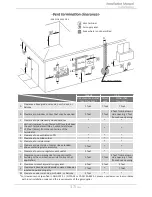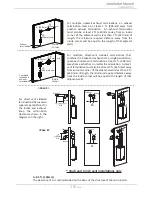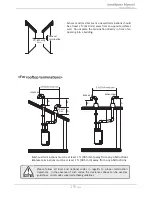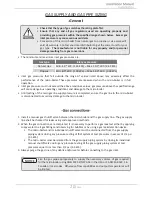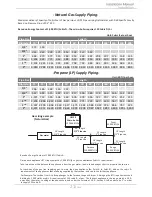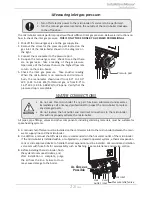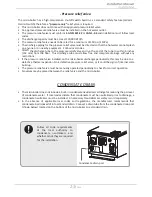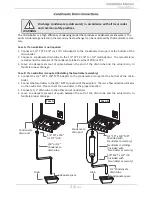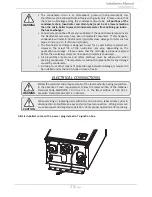
10
Page
VENTING INSTRUCTIONS
For the 140 Indoor (T-H3M-DV) model
-General-
•
Improper ven
ting
of this appliance can result in excessive levels of carbon
monoxide which can result in severe personal injury or death.
•
Improper installa
tion
can cause nausea or asphyxia
tion,
severe injury or death
from carbon monoxide and
flue
gases poisoning. Improper installa
tion
will
void product warranty.
DANGER
When installing the vent syst
em,
all applicable na
tional
and local codes must be
followed. If you install
thimbles,
fi
re stops or other prot
ecti
ve devices and they
penetrate any combus
tible
or noncombus
tible
cons
truction,
be sure to follow all
applicable na
tional
and local codes.
CAUTION
The micro-boiler must be vented in accordance with the
section
“Ven
ting
of Equipment" of the latest
edition
of the Na
tional
Fuel Gas Code: ANSI Z223.1/NFPA 54 in the United States and/or
Section
7 of the
CAN/CSA B149.1 Natural Gas and Propane Installa
tion
Code in
Canada,
as well as applicable local building
codes.
The use of ven
ting m
aterials approved for Category III/IV appliances is recommended whenever possible.
However
,
the micro-boiler may also be vented with plas
tic
pipe materials such as
ABS,
PVC
,
CPVC
,
or
Polypropylene.
For details, please refer to the Exhaust Vent (ABS, PVC, CPVC, or Polypropylene Vent)
section
on p. 11.
Vent installa
tions
in Canada which
utili
ze plas
tic
vent systems must use ven
ting
that
complies with ULC S636.
General rules for ven
ting
micro-boiler are:
•
Place the micro-boiler as close as possible to the vent termina
tion.
•
The vent collar of the micro-boiler must be fastened directly to an unobstructed vent pipe.
•
Do not weld the vent pipe to the micro-boiler’s vent collar.
•
Do not cut or alter the vent collar of the micro-boiler.
•
The vent must be easily removable from the top of the micro-boiler for normal service and
inspection
of the unit.
•
Avoid using an oversized vent pipe or using extremely long runs of the pipe.
•
For roo
ft
op ven
tin
g
,
a rain cap or other form of termina
tion
that prevents rain water from
entering into the micro-boiler must be installed.
•
Do not terminate the vent into a chimney. If the vent must go through the chimney
,
the vent
must run all the way through the chimney with approved vent pipe.
General rules for vent termina
tions:
•
Avoid loca
ting
the micro-boiler vent termina
tion
near
any air intake devices
. These fans can
pick up the exhaust
flue
products from the micro-boiler and return them to the building. This
can create a health hazard.
•
Locate the vent termina
tion
so that it cannot be blocked by any
debris,
at any
time
. Most codes
require that the termina
tion
be at least 12 inches (305 mm) above gr
ade,
but the installer may
determine if it should be higher depending on the job site c
ondition
and applicable codes.
•
A proper sidewall termina
tion
is recommended when the micro-boiler is vented through a
sidewall.
•
Regarding the clearances from the exhaust termina
tion
to the air inlet or opening
,
refer to p. 17
to 19.
Summary of Contents for HS120CON-LP
Page 27: ......

















